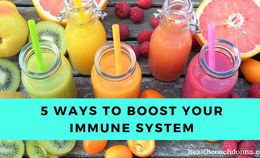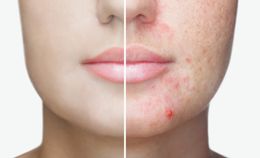Do you or someone you know live with nervousness, anxiety, headaches, ADD/ADHD, or gastro issues? An elimination diet may be the answer to these experiences. But it can be a challenge with the many types of elimination diets, which one to do, how to do it, and how to plan for meals when doing an elimination diet.
What is an Elimination Diet?
The elimination diet is the gold standard for assessing food sensitivities, and it has the benefit of being absolutely specific to you - the start of discovering your own very personal, optimized nutrition plan.
An elimination diet can serve as an extraordinarily accurate guide through the complex food universe we live in.
It's something you can do on your own before even seeing your doctor or nutritionist. Simply bring the results in with you to your first visit to save time and help focus your work together.
Essentially, an elimination diet is a simple self-assessment tool used to identify food sensitivities that may be causing adverse effects.
Food sensitivities are not the same as food allergies.
What's the Difference Between a Food Allergy and a Food Sensitivity?
A food allergy is an immune system response triggered by a food or a substance in a food and can include digestive symptoms, itchiness, hives or swollen airways. (A peanut allergy, for example, may even cause cardiac arrest.) Blood or skin tests can confirm that you have an allergy to a specific food.
However, even if you have tested negative for an allergy to a given food, you may have a sensitivity to that food and have a reaction when you eat it.
Dr. Susan Blum explains, "Food sensitivities still involve a reaction from your immune system, causing inflammation in your body, which is not good if you have an autoimmune disease. However, modern medicine just doesn't have the right tests yet to determine food sensitivities, so we have a different way to confirm if you have a problem with a particular food."
The 5 Steps to How an Elimination Diet Works
There is a five-step process for doing an elimination diet:
1. Exclude: Potential problem foods for a period of time
2. Reintroduce: One-by-one
3. Observe: The body's responses to food that is reintroduced
4. Log: Keep a journal of changes observed
5. Determine: Which foods are triggers that should be excluded
How Does an Elimination Diet Work?
An elimination diet works by hitting the reset button on the body's immune system. Foods that a body views as offensive leads to the body creating antibodies, which fight off those foods.
The Elimination Diet prevents you from consuming certain foods and gives the body the opportunity to cleanse itself of the developed antibodies.
The reintroduction of eliminated foods then gives the person doing the elimination diet the chance to see what reactions their body has to foods with a cleaned immune system.
Elimination diets inspire greater body awareness that can serve you well. You are more likely to notice when something you eat causes you to feel:
- Sluggish
- Drowsy
- Bloated
- Overly irritable
How Long do you Have to do an Elimination Diet?
Nutritionists and other practitioners often get asked: How long do you have to go through an elimination diet?
A good rule of thumb is three weeks to help the body fully cleanse from built up antibodies. Then when reintroducing foods wait at least three days between reintroductions so you can document any reactions your body has to foods being reintroduced.
How an Elimination Diet Puts You in Charge of your Health
An elimination diet is a way of taking action and will support your ongoing health.
Annina Burns, Ph.D., functional nutritional expert in women's health, frequently recommends elimination diets for her patients and finds that this can be a very rewarding process. "An elimination diet is one of our best assessment tools to personalize a nutrition plan targeted to the health challenges you are going through," she says, "You monitor your own symptoms as you reintroduce each food. You're in control."
Looking for reasons why you should start an Elimination Diet?
8 Reasons to Try an Elimination Diet
Many people find they experience discernible, even dramatic improvements in their overall health simply by removing offending foods from their diets.
Here are eight reasons why trying an elimination diet may improve your life:
1. Increased energy
2. Improved sleep
3. Better brain functioning
4. Fewer mood swings
5. Less irritability
6. Better digestion
7. Clearer skin
8. Overall rejuvenated wellness and vitality
Wondering what conditions can benefit from completing an elimination diet?
27 Conditions and the Benefits of an Elimination Diet
While elimination diets are a superb assessment tool, simply doing one can itself make you feel better - you may experience benefits either quickly or overtime. Many people wonder, what can an elimination diet help treat? Here is a list of 26 conditions that can benefit from an elimination diet:
2. ADHD/ADD
3. Autism
4. Chronic pain
5. Joint pain
6. Anxiety
7. Fatigue
8. Fibromyalgia
9. Skin conditions
10. Canker sores
11. Stress levels
12. Digestive distress
13. Depression
14. Mood swings
15. Energy levels
17. Headaches
18. Weight loss
19. Multiple Sclerosis
20. Brain fog
22. IBS
23. Hot flashes
24. Rosacea
25. Acne
27. Leaky gut syndrome
Often times, antibodies build up by the immune system because of offending foods, causing inflammation. By removing offending foods that promote inflammation, many find significant relief for a wide range of chronic conditions.
An elimination diet can also be a refreshing reboot to your food life. We all get stuck in food ruts!
Three weeks of clean eating can help you detoxify, cleanse your palate and reignite your love of healthy food. It can also be helpful to do elimination diets from time to time throughout your life since our bodies change and evolve as we age. What works well for you at age twenty, may not at forty or sixty.
Elimination Diets: One Size Does Not Fit All
How do you know what you should eat? Paleo or vegetarian? With or without grains? Are corn, wheat or soy good or bad? Are eggs ok?or not?
What's good for another person may not be good for you.
Your biochemistry is unique, and your current health status is partly a result of your genetic predisposition interacting with your environment over the course of your life. The food you bring into your body is the largest environmental exposure you have. By exploring your body's reactions to foods and removing those that are difficult for you, you are laying important groundwork to enable your body to heal itself. This is called personalized nutrition and is one of the most powerful wellness tools.
3 Main Forms of Elimination Diets
A study conducted by the Child and adolescent psychiatric clinics of North America, on the Restriction and Elimination Diets in ADHD Treatment, found that no matter the condition being treated by an elimination diet, elimination diets take the following three forms:
Single food elimination: Excluding a single food item such as eggs.
Multifood elimination: Excluding multiple food items.
Few foods diet: Restricting food items eaten to only a few items.
It should be noted that the few foods diet should be done with the help of a nutritionist. This will ensure that when only eating a few foods, you do not experience deficiencies in vitamins and other nutrients.
That being said, let's look at the 6 types of elimination diet so you can find the right fit for you:
6 Types of Elimination Diets
1. Six food elimination diet: Removing the six common food allergens cow-milk protein, soy, wheat, eggs, peanuts, and seafood.
2. Gluten-free diet: Removing all foods that contain gluten.
3. Nightshade elimination diet: Removal of all foods in the nightshade family .
4. FODMAP diet: Removing all fermentable sugars.
5. Mold elimination diet: Removing foods that are known to have mold content in them .
6. Feingold diet: Excluding all food colorings and preservatives.
Safety Concerns and Side Effects
There are no safety concerns nor side effects from doing an elimination diet if done correctly.
You may start feeling better; but before you start feeling better, you may feel worse. You might miss that food you've taken out; you might even crave it. Through the process, you may discover that that food is actually causing discomfort. By just doing the diet, you may find you may begin to experience relief of symptoms and feel markedly better.
Ready to get started on your elimination diet journey?
References:
Restriction and Elimination Diets in ADHD Treatment. (n.d.). Retrieved November 9, 2018, from https://www.ncbi.nlm.nih.gov/pmc/articles/PMC4322780





















